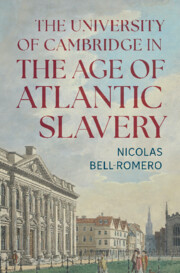Appendix A: Cambridge Families and the Transatlantic Economy
The opening paragraphs in the first chapter discuss the prospographical methodology used to analyse the students who were admitted to the University of Cambridge from families with a wide variety of connections to and involvement in the transatlantic economy. The four tables below illustrate the findings on student birthplaces, familial involvement in that economic system, and the various colleges that these undergraduates attended. The sample has omitted South Sea and Royal African investors to focus on families who shaped these activities on the ground.
Table 1 illustrates the variety of overseas (outside of mainland Britain) and local locations from which 847 Cambridge students originated. The data is remarkably consistent with other studies in suggesting the significance of Barbados, Jamaica, London, and Liverpool to the emergence of a class who were actively engaged in the Atlantic economy.
Table 1 Student Birthplaces
| Location | Number of Students | Location | Number of Students |
|---|---|---|---|
| Overseas Locations | British Locations | ||
| Antigua | 46 | Bedfordshire | 3 |
| Bahamas | 4 | Berkshire | 4 |
| Barbados | 140 | Buckinghamshire | 2 |
| Bermuda | 14 | Isle of Bute | 1 |
| British Guiana | 9 | Cambridgeshire | 5 |
| Demerara | 1 | Cheshire | 7 |
| Dominica | 5 | Cornwall | 1 |
| Jamaica | 113 | Cumberland | 3 |
| Montserrat | 10 | Denbighshire | 8 |
| St Kitts | 12 | Derbyshire | 2 |
| St Lucia | 1 | Devonshire | 5 |
| St Nevis | 6 | Dorset | 1 |
| St Vincent | 3 | Essex | 8 |
| Trinidad and Tobago | 4 | Edinburghshire | 5 |
| Virgin Islands | 3 | Fife | 1 |
| Connecticut | 1 | Flintshire | 2 |
| Virginia | 33 | Hampshire | 3 |
| Maryland | 6 | Hertfordshire | 9 |
| Massachusetts | 3 | Huntingdonshire | 1 |
| New York | 9 | Isle of Wight | 1 |
| Pennsylvania | 2 | Kent | 6 |
| Rhode Island | 1 | Kirkcudbrightshire | 1 |
| South Carolina | 17 | Lanarkshire | 3 |
| France | 1 | Lancashire | 76 |
| Ireland | 12 | Lincolnshire | 2 |
| Total | 456 | Middlesex | 132 |
| Northamptonshire | 7 | ||
| Northumberland | 1 | ||
| Nottinghamshire | 4 | ||
| Rutland | 2 | ||
| Somerset | 20 | ||
| Staffordshire | 2 | ||
| Stirlingshire | 1 | ||
| Suffolk | 12 | ||
| Surrey | 7 | ||
| Sussex | 9 | ||
| Warwickshire | 1 | ||
| Westmorland | 1 | ||
| Wiltshire | 2 | ||
| Worcestershire | 1 | ||
| Yorkshire | 20 | ||
| Total | 391 | ||
In discussing student numbers at academic institutions, there is a tendency to either focus on plantation owners or merchants in the transatlantic trade in enslaved Africans. However, individuals and families were often both slave-traders and plantation owners or bankers and merchants involved in the carrying trade of goods to North America and the Caribbean. Table 2, which utilises data from the Legacies of Slave-Ownership database and other primary and secondary sources, accounts for the varieties of engagement in enslavement for 850 students and their families.
| Occupation | Number of Students |
|---|---|
| Planter | 629 |
| Planter and Merchant | 47 |
| Banker and Planter | 12 |
| Planter and Slave-Trader | 17 |
| Banker | 26 |
| Banker and Merchant | 7 |
| Banker and Slave-Trader | 2 |
| Merchant | 52 |
| Merchant and Slave-Trader | 10 |
| Slave-Trader | 44 |
| Cotton Manufacturer | 4 |
Cambridge reflected the hierarchical nature of wider British society. For 832 students in the sample, their college rank has been recorded, particularly if they changed statuses multiple times whilst at the University (Table 3).
| Rank | Number of Students |
|---|---|
| Nobleman | 8 |
| Sizar | 27 |
| Sizar then Pensioner then Fellow-Commoner | 1 |
| Pensioner | 571 |
| Pensioner then Scholar | 2 |
| Pensioner then Fellow-Commoner | 14 |
| Pensioner then Nobleman | 1 |
| Fellow-Commoner | 203 |
| Scholar | 5 |
Table 4 lists in alphabetical order the colleges that students attended. The numbers, which are double-counted, account for the fact that undergraduates often attended multiple institutions whilst at Cambridge.
| Colleges | Number of Students |
|---|---|
| Christ’s | 40 |
| Clare | 31 |
| Corpus Christi | 14 |
| Downing | 3 |
| Emmanuel | 29 |
| Gonville and Caius | 33 |
| Jesus | 19 |
| King’s | 3 |
| Magdalene | 14 |
| Pembroke | 35 |
| Peterhouse | 35 |
| Queens’ | 35 |
| Sidney Sussex | 12 |
| St Catharine’s | 12 |
| St John’s | 160 |
| Trinity | 329 |
| Trinity Hall | 53 |
